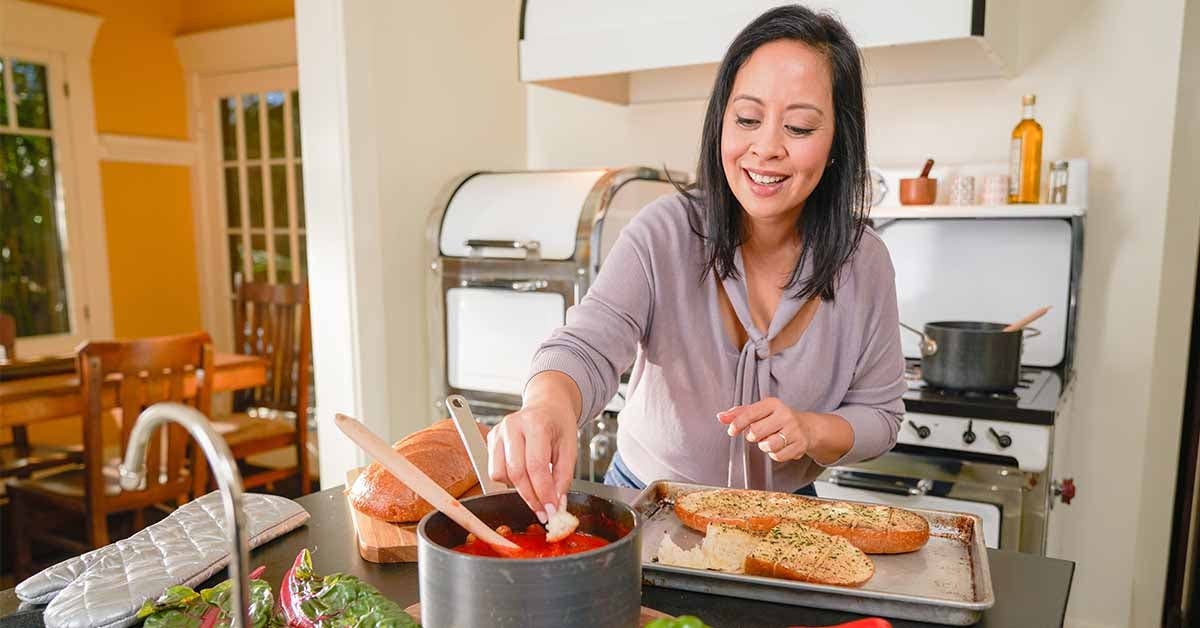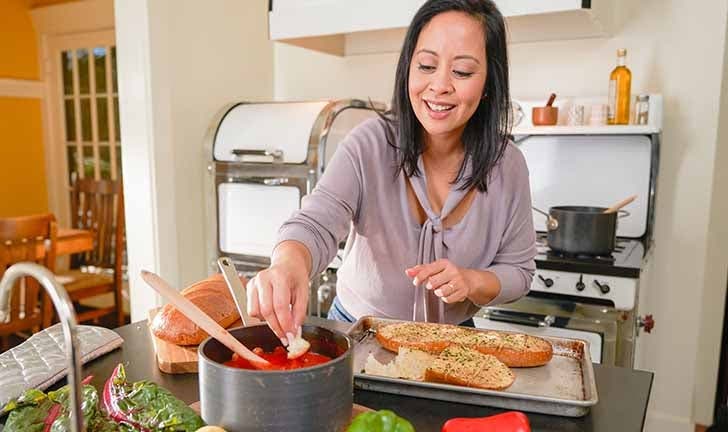

Carbs get a pretty bad rap in a lot of circles, but in truth, they’re not all bad. You just have to know a little bit about them.
So, let’s start at the beginning. First of all, what are carbs, really? You probably think of bread or pasta when you hear the word “carbs”, but they are way more than that.
“Carbohydrates” is an umbrella term for several types of carbohydrates, explains Amanda A. Kostro Miller, RD, LDN, who serves on the advisory board for Fitter Living.
“Carbs are used as the body’s preferred energy source,” she says, adding, “Carbs give your body energy so that it doesn’t have to burn protein or dietary fat. Dietary protein and fat have other, more important roles in your body than energy production. Getting enough carbs fights off fatigue and gives you energy to live a healthier lifestyle full of activity and exercise.”
What happens with carbs is people often use that umbrella term to refer to all of them, the ones that are good for us, and the ones that aren’t so good for us, and lump them all together.
“It’s not carbs, it’s processed carbs,” clarifies Jillian Michaels, health and fitness expert and creator of The Fitness App. “And these types of processed grains and refined sugars deserve a bad rap. They are empty calories filled with crap that make us heavy and unhealthy.”
Kostro Miller adds, “There are healthy carbs and no-so-healthy carbs. Healthy carbs give you tons of nutrition, energy, fibre and/or micronutrients: fruits, vegetables, whole grains, legumes, low-fat dairy. Unhealthy carbs should just be used as treats: candy, desserts, processed snack foods, sodas.”
Here’s Kostro Miller’s list of “good” carbs.
- Whole grains from whole grain bread, whole grain pasta, whole grain crackers and starchy vegetables (potatoes with skin, corn, peas) – “These carbs give you long-term energy.”
- Fruits and vegetables – these are carbohydrate foods that give you fibre, water, vitamins and minerals
- Low-fat/non-fat dairy (i.e. milk, yogurt, cheese) – these are also sources of carbohydrates that provide protein as well
“However,” says Kostro Miller, “there are carbohydrate sources that should be limited for general health and for weight loss to control your calorie intake. These types of carbs have lots of calories and minimal nutrition, so you may hear them called ‘empty calories’: sugar, cakes, cookies, chips, syrup, sweeteners, candy, bakery items, juices, sugar-sweetened beverages (soda, sports drinks).”
So what’s with all the misconceptions around carbohydrates?
“There is so much conflicting information driven from fad diets that people don’t understand healthy carbohydrates are essential for our health,” Michaels says. “They are also not informed on the quality of carbohydrates – why and how this matters. So they just hear that carbs are bad from ridiculous diets like keto.”
Michaels adds, “Carbs are not the devil. Fad diets and big food companies creating garbage for profit margin are. Don’t fear whole foods, know your calorie allowance as even the healthiest food can make us overweight if we overeat it.”
What’s the right balance of carbs on my plate?
Guidelines are general, and the right balance for you will depend on your lifestyle, but here’s a rough idea.
“According to the 2015-2020 Dietary Guidelines,” says Kostro Miller, “a balanced diet should consist of 45-65 per cent calories from carbs (and 20-35 per cent from fat and 10-35 per cent from protein). For starches and starchy vegetables (bread, pasta, potatoes, corn, peas et cetera), try to keep your starch portions to about 1/4th of the plate. For non-starchy vegetables, try to make them take up about 1/2 of your plate. Fruit can be used as a side or dessert, and you should try to get at least three servings of fruit per day.”
Michaels adds, “Depending on your level of physical activity, carbs can be anywhere from 60 per cent to 40 per cent of a healthy diet. Now, with that said, the quality of these carbohydrates varies greatly and matters tremendously. What that 60-40 per cent consists of is key.”
This is where you want to be prioritizing those good-for-you carbs.
“When it comes to fruits and vegetables, to be honest, you really never need to limit this. And yes, that goes for fruit, too,” Michaels says. “It’s highly unlikely you could consume enough fruit to put you well over your daily calorie allowance and/or spike your blood sugar in a way that could create insulin-related health issues. Fruit is packed with fibre, which makes it not spike your blood sugar like typical sugar, and also keeps you from overeating it.”
Plus, she says, with fruit and veggies you’re getting not just fibre and water, but also loads of vitamins, minerals, digestive enzymes and phytonutrients.
“Then you have beans, legumes and whole grains,” Michaels says. “These are also perfectly fine, healthy and good for you.” She explains that these foods won’t spike your insulin and are also loaded with fibre, vitamins, and minerals.
Cravings explained
That umbrella term of carbs is also tied to the cravings many of us have for processed treats like baked goods or chips.
“We know these foods trigger our brain chemistry in a way that provides quick hits of ‘pleasure,’” Michaels explains. “On top of it, some of us tend towards utilizing food as a coping mechanism. This combo can prove deadly, literally creating a physical, emotional and psychological addiction to this type of ‘food.’”
“Oftentimes our cravings are a result of common behaviours,” Kostro Miller says. “Hormonal shifts can spark hunger and cravings as well (i.e. menstrual hormonal changes) but those are often temporary. To combat seemingly unrelenting cravings that you get every day, replace the refined carbs with healthy carbs like whole grains, ancient grains, sweet fruits and vegetables.”
Stress also plays a role in when our cravings kick in, so it’s important to find ways to manage your stress – try guided meditations with Headspace in the WW app – and to try to recognize when stress is triggering a craving.
Kostro Miller explains how the stress-craving trigger works: “Cortisol is a stress hormone that increases in times of chronic stress, [and it] can stimulate hunger and a strong will to eat. Furthermore, cortisol itself may make us crave foods that are high in sugar, calories and fat. Also, besides the fact that cortisol makes you want to eat more, cortisol can also affect how your body is able to feed your cells, making the process less efficient. So, not only are you possibly stress eating (and eating lots of calories), your body cannot efficiently feed your cells, making your cells feel as if they still need more nutrition. It can be a vicious cycle!”
Ideally, if you can remove the “stressors” from your life, that would help greatly, Kostro Miller says, but she knows that may not be possible.
She suggests keeping a regular eating schedule “where you avoid ever getting too hungry and avoid ever stuffing yourself to the brim. Before grabbing a snack, take a minute to ask yourself if you are truly hungry. You may find that you are really just stressed and looking for something to munch on or you are bored. Try to structure an eating routine where you eat a meal/snack every three [to] four hours while awake.”
Michaels would love it if we all could cut processed, unhealthy carbs out of our lives entirely, but she knows that kind of restriction just isn’t realistic.
“So, here is what I do with these types of foods – I give myself the 80/20 rule and I ensure that I keep these foods to under 20 per cent of my daily calorie allowance. So if I eat 1,800 calories, I don’t go over 360 calories of these types of foods.”
To combat cravings, Michaels suggests practising behavioural techniques like removing processed foods from your immediate environment whenever possible.
“And then if you need more help, a great therapist can work with you to explore the deeper meanings behind why some of us are more inclined to use these foods for comfort.”
